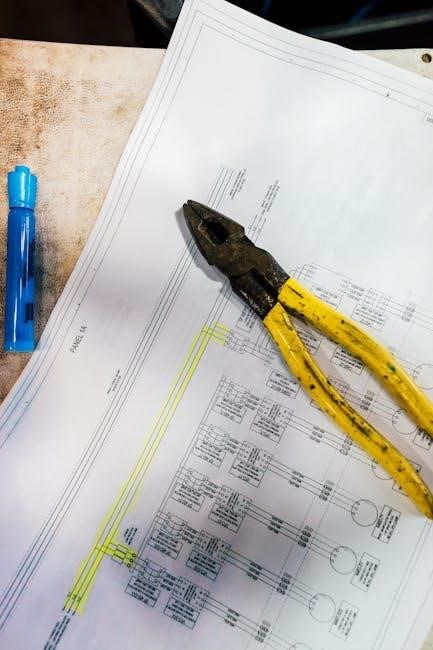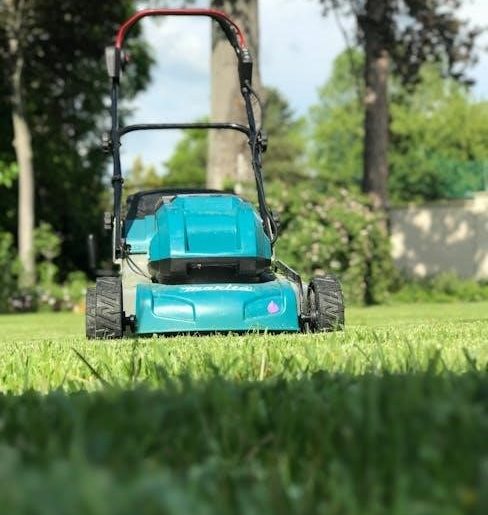Safety Precautions
Always ensure proper grounding and use a GFCI-protected outlet to prevent electric shock. Read the manual thoroughly before operation. Follow all safety guidelines to avoid injury or damage.
1.1 Grounding and GFCI Protection
Your Ryobi electric pressure washer is equipped with a ground-fault circuit interrupter (GFCI) built into the power cord plug for enhanced safety. This device protects against electric shock by interrupting the power supply if a ground fault is detected. Always ensure the unit is properly grounded before use. Avoid using the pressure washer in wet conditions or near water sources to minimize the risk of electrical hazards. Never bypass or modify the GFCI or grounding system‚ as this could lead to serious injury or death. Use only GFCI-protected outlets rated for the pressure washer’s power requirements. Regularly inspect the power cord for damage or wear‚ and replace it immediately if any issues are found. Proper grounding and GFCI protection are critical for safe operation and must never be overlooked.

1.2 Essential Safety Instructions
Before operating your Ryobi electric pressure washer‚ carefully read and follow all safety guidelines in the manual. Always wear protective eyewear and avoid loose clothing that could get caught in moving parts. Ensure the area is clear of debris and flammable materials. Keep children and pets away during operation. Never use the pressure washer near open flames or sparks‚ as this could pose a fire hazard. Avoid spraying electrical components‚ sensitive surfaces‚ or people‚ as the high-pressure stream can cause damage or injury. Use the correct nozzle for the task to prevent accidental damage. Regularly inspect hoses and connections for wear or leaks. Do not modify the unit or bypass safety features. Store the pressure washer in a dry‚ secure location when not in use. Always disconnect the power cord when leaving the unit unattended or during maintenance.

First-Time Assembly

Assemble your Ryobi electric pressure washer by attaching the high-pressure hose to the main unit‚ securing the trigger handle‚ and connecting the spray wand. Refer to the manual for detailed instructions.
2.1 Quick Reference Guide

Start by unpacking and inspecting all components for damage. Attach the high-pressure hose to the pump and spray wand. Connect the garden hose to the water inlet‚ ensuring a secure fit. Plug in the power cord‚ making sure the outlet has GFCI protection. Check the detergent tank if using soap. Select the appropriate nozzle for your cleaning task—15º for heavy-duty cleaning‚ Turbo for large areas‚ or Soap for detergent use. Turn on the water supply‚ then press the trigger to start the unit. For first-time operation‚ test the spray wand at low pressure before increasing power. Always follow the manual’s instructions for proper assembly and operation to ensure safety and optimal performance.

2.2 Starting the Unit
To start the Ryobi electric pressure washer‚ ensure all connections are secure. Plug the unit into a GFCI-protected outlet and turn on the water supply. Allow water to flow through the hose for 30 seconds to prime the pump. With the spray wand in the locked position‚ press the power button. The unit will begin building pressure. For initial use‚ test the spray wand at low pressure to ensure proper function. Avoid starting the unit without water supply to prevent damage. If using detergent‚ ensure the tank is properly attached and the correct nozzle is selected. Always refer to the manual for specific startup procedures to ensure safe and efficient operation. Proper startup ensures optimal performance and longevity of the pressure washer. Follow these steps carefully to avoid any issues during operation.

Operating the Pressure Washer
Operate the Ryobi pressure washer by selecting the appropriate nozzle for the task. Use detergent only in the designated tank. Adjust pressure settings as needed for different surfaces. Always refer to the manual for guidance on safe and effective operation.
3.1 Using Detergent
When using detergent with your Ryobi electric pressure washer‚ ensure it is specifically designed for pressure washers to avoid damaging the system. Fill the detergent tank with the recommended amount‚ avoiding overfilling. Use the soap nozzle for detergent application‚ as it is designed to dispense the correct amount of detergent. Always rinse surfaces thoroughly after applying detergent to prevent residue buildup. For tough stains‚ allow the detergent to sit for a few minutes before rinsing. Never use household cleaners or abrasive chemicals‚ as they may damage the washer or harm surfaces. Refer to the manual for compatible detergent types and usage guidelines. Proper detergent use ensures effective cleaning and prolongs the life of your pressure washer. Always follow safety precautions and manufacturer recommendations when using detergent.
3.2 Spray Nozzles and Their Applications
Your Ryobi electric pressure washer comes with multiple spray nozzles‚ each designed for specific tasks. The 15° nozzle is ideal for heavy-duty cleaning‚ such as concrete or tough stains‚ due to its concentrated spray. The Turbo nozzle provides a wide fan pattern for general cleaning and is effective for large areas like driveways or siding. The Soap nozzle is designed for applying detergent and should only be used with compatible pressure washer detergents. Always select the appropriate nozzle for your cleaning task to ensure optimal results and avoid surface damage. For delicate surfaces‚ use a wider nozzle like the Turbo to prevent damage. Never use the wrong nozzle‚ as it may lead to inadequate cleaning or surface harm. Refer to the manual for guidelines on nozzle usage and maintenance. Proper nozzle selection enhances cleaning efficiency and protects surfaces from damage.

Maintenance and Troubleshooting
Regularly inspect and maintain the pressure washer to ensure optimal performance. Check for worn or damaged parts and replace them promptly. Drain the hose after use to prevent freezing. Troubleshoot common issues like low pressure by checking for blockages or incorrect nozzle usage. Refer to the manual for specific guidance on repairs and maintenance procedures.
4.1 Routine Maintenance Tips
Regular maintenance is crucial for extending the life of your Ryobi electric pressure washer. Always inspect the high-pressure hose for signs of wear or damage and replace it if necessary. Lubricate connections and moving parts periodically to ensure smooth operation. Clean the filter regularly to maintain proper water flow and pressure. After each use‚ drain the hose and pump to prevent freezing in cold temperatures. Store the unit in a dry‚ protected area during the off-season. Check and replace worn nozzles or seals as needed. Follow the recommended maintenance schedule outlined in the manual to keep your pressure washer functioning optimally. Proper care will enhance performance and reliability over time. Consult the manual for specific guidance on replacing parts and troubleshooting common issues.
4.2 Troubleshooting Common Issues
Common issues with your Ryobi electric pressure washer can often be resolved with simple troubleshooting. If the unit does not turn on‚ check the power source and ensure the circuit breaker has not tripped. Low pressure may indicate a clogged nozzle‚ kinked hose‚ or insufficient water supply. Clean or replace the nozzle and check for kinks in the hose. If the unit overheats‚ allow it to cool before restarting. For leaks‚ inspect connections and tighten any loose fittings. If detergent is not dispensing properly‚ ensure the detergent tank is filled correctly and the dial is set to the soap setting. Refer to the manual for guidance on replacing worn seals or faulty parts. Regular maintenance can prevent many of these issues. Always follow the troubleshooting steps outlined in the manual to ensure safe and effective resolution.
